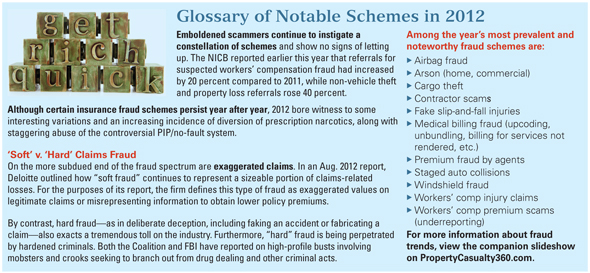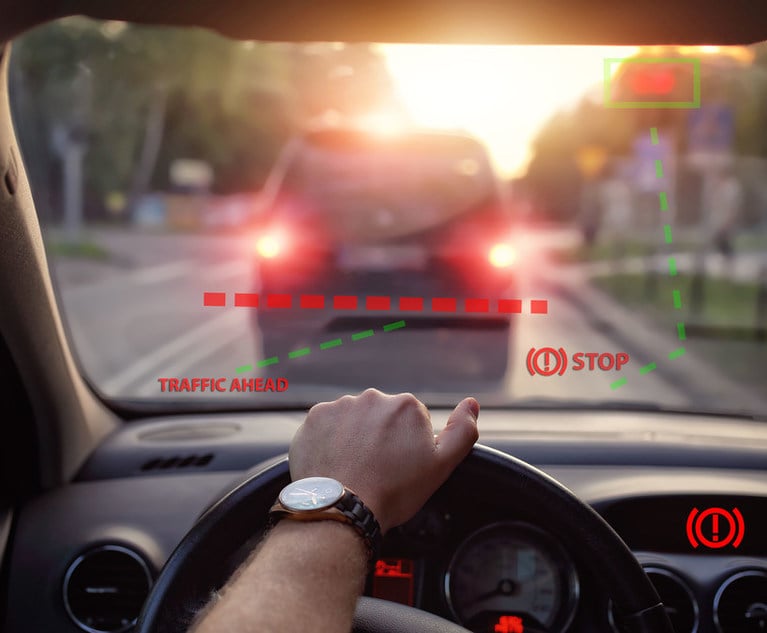(Editor's Note: This article has been contributed by JanineJohnson, an analytics manager at the ISO Innovative Analytics (IIA)unit of Verisk Analytics (www.verisk.com).
|It's no secret: Fraudulent claims continue to be an insidiousproblem for the industry, costing P&C insurers and consumers anestimated $40 billion a year (according to the FBI). Of course,that figure stands to skyrocket as the National Insurance CrimeBureau (NICB) reports that questionable claims (QCs) increased anunprecedented 20 percent during the first half of 2012 whencompared to the same period in 2011.
|Fraud is highly adaptive, responding to external stimuli andevolving over time. Historically, fraud has shifted from primarilyvehicle thefts and property arson to the casualty side, as specialinvestigative units (SIUs) clamped down on property scams. Casualtyclaims are notoriously more complex, involving collusion betweenphysicians and lawyers and larger dollar amounts. These sumsdraw the attention of organized rings involving medicalprofessionals and criminal syndicates.
|As the battlefield continues to shift and grow, it is imperativefor P&C insurance carriers to adapt faster than the fraudsters by employing cutting-edgetools and making fraud fighting integral to every point in theinsurance transaction. The key elements of this strategyinclude:
- Identifying potential problems during underwriting, preferably at time of application forpolicy.
- Using claims triaging models to properly segment claims and reduceworkload.
- Adopting the most advanced tools and techniques to detect the truly suspicious claims.
- Keeping an eye on future technologies, particularly those usedin other disciplines.
Perimeter Defenses
|The proliferation of direct-channel business createsopportunities for fraud that didn't exist prior to the viability ofonline policy processing. Early warning signs may include numerousapplications coming from a single Internet protocol (IP) address.Additionally, IP addresses from unlikely places, such as statesother than those in which a carrier does business, should raise ared flag. Insurers also need to evaluate the e-mail addresssupplied. E-mail addresses containing the applicant's name withcorporate domains or well-known Internet service providers tend tobe more credible than applications with a more anonymous andobscure points of origin.
|Aside from those technological patterns, many traditionalfraud indicators that are present at the time of a claim arealso present at the time of application. Make use of thisinformation to help identify policies that may be purchased simplyto commit fraud.
|No single indicator suffices to deny coverage, but applicationsthat raise suspicion should be taken off of the direct-channelconveyor belt and placed in front of an underwriter, who will askadditional questions to verify information prior to grantingcoverage. In many instances, a dishonest applicant will notcontinue with the submission process when required to be in directcontact with an underwriter.
|Claims Segmentation
|Another proven fraud-fighting technique is to start bysegmenting the legitimate claims. Doing that serves two purposes:First, the sooner a legitimate claim gets paid, the greater acustomer's satisfaction with the company. Second, quicklyidentifying claims to fast track reduces the total number of claimsthat require adjuster or SIU scrutiny. This allows limited claimand investigative resources to focus on claims with some degree ofsuspicion—saving time and money by putting resources where they areneeded most.
|Step one in the segmentation process is identifying“contra-indicators” in the claim file. Contra-indicators are claimcharacteristics that indicate a claim is likely legitimate and maybe paid as expeditiously as possible. For example, a police report,confirmation of transportation by an ambulance, or tests and imagesverifying an injury may all indicate a claim's legitimacy.
|Cutting-Edge Detection Technology
|Once legitimate claims are paid, remaining claims call forefficient fraud detection tools. Fortunately over the past decade,the reduced cost of data storage and the exponential increase incomputing power have yielded the ability to leverage moreinformation than ever.
|
Text mining has become more accessiblebecause of increased computing. Among the most common applicationsof this technology is the mining of claims adjusters' diaries.Ideally, an adjuster should recognize and escalate the samesuspicious indicators that text mining uncovers. Unfortunately,lack of training or time constraints can prevent an adjuster frompicking up on those red flags. Text mining applies a consistentlevel of scrutiny to every diary entry, ensuring that even subtleindicators will not go undetected.
|A second powerful technique that is rarely used is anomaly, oroutlier, detection. The algorithms involved are computationallyintensive yet extremely powerful for identifying behavior that doesnot fit the norm. Adopted from artificial intelligence, thealgorithms learn new patterns to detect unusual characteristicseven if the anomalous behavior does not include hallmark SIU redflags. This allows potentially problematic patterns to beidentified earlier and put into the SIU pipeline forinvestigation.
|The last decade also has witnessed a growth in theidentification and analysis of networks, which has resulted in abroad area of research known as social network analysis. Harnessingthat research for use in the P&C insurance industry providesthe ability to identify fraud rings running various scams,including the following:
- Staged accidents
- Medical provider collusion
- Attorney collusion
Network technology allows insurers to construct holistic claimnetworks proactively without the need for a known suspect startingpoint. Once constructed, the networks are scored using advancedpredictive analytics that identify those that have unusual orsuspicious characteristics. This technology will highlight networksbefore they fully metastasize by tracking various network velocitymeasures, such as changes in claim volume. This allows carriers tointervene much earlier in the process and avoid millions of dollarsof fraudulent payouts.
|Next Generation
|Finally, claims executives need to keep abreast of tools andtechniques used in other industries or disciplines. Often, bestpractices developed by others can be easily adapted quickly andeffectively to the P&C industry.
|Next-generation detection systems will help predict geographicmigration patterns of fraud activity and identify false medicalclinics attempting to mask their identity. They will include moreand wider-ranging data sources, such as analysis of vehicle andmedical images, automated use of social media, voice analysis, andGPS and cell phone data. To make the claims team as efficient aspossible, always consider adopting the latest available technologyfrom multiple disciplines.
|The fight against fraud is a constant struggle to thwartever-changing crooks. In order for carriers to adapt faster thancriminals, they must adopt a multipronged approach to fightingfraud that relies upon vigilant detection at every stage of theinsurance life cycle.
Want to continue reading?
Become a Free PropertyCasualty360 Digital Reader
Your access to unlimited PropertyCasualty360 content isn’t changing.
Once you are an ALM digital member, you’ll receive:
- All PropertyCasualty360.com news coverage, best practices, and in-depth analysis.
- Educational webcasts, resources from industry leaders, and informative newsletters.
- Other award-winning websites including BenefitsPRO.com and ThinkAdvisor.com.
Already have an account? Sign In
© 2024 ALM Global, LLC, All Rights Reserved. Request academic re-use from www.copyright.com. All other uses, submit a request to [email protected]. For more information visit Asset & Logo Licensing.








